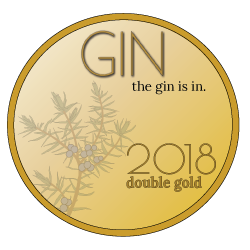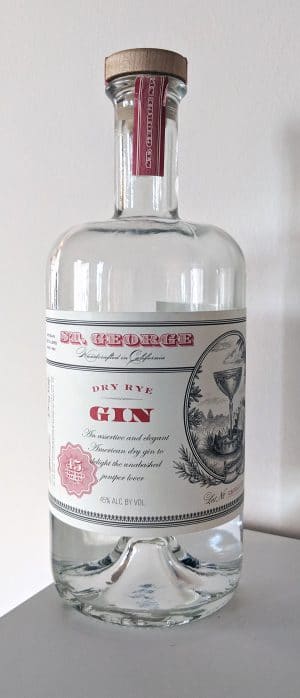Flavor Profile
Around the turn of the 20th century you could find two broad categories of gin. Brand names and local no-name gins. If you look at a stockist’s roster you will find these gins generically referred to by their grain— for example “Barley Gin” or “Rye Gin.” Rye was once a somewhat common alternative grain for gin to be based on. In that way St. George’s Dry Rye Gin is a bit of a throwback.ch
100% distilled from malted rye on a 1,500 liter copper pot still. In order to have the botanical presence of juniper compete with the flavorful base spirit, the team at St. George’s increased the amount of juniper by 50% when compared to their Botanivore and Terroir Gins.
Tasting Notes
Dry Rye Gin has a nose suggestive of genever. Warm hay and malted grain tones with a yeasty, brewery aroma. Lime zest, and herbaceous juniper lend color and character.
The palate begins with some notes suggestive of beer schnapps and white whiskey— the impact of the rye base is evident at the front of the palate. The botanicals take over mid-palate a bit wherein hints of aniseed, cracked black peppercorn, and quite a bit of citrus.
The flavor profile of Dry Rye Gin is round and full. Juniper adds some scintillating pine notes towards the finish, but the juniper despite being so dominant in terms of botanical ratio, adds a woody, earthier character than the traditional pine.
The finish reminds me a bit of Aquavit. Notes of caraway, grain and rye suggest to me perhaps a hint of Jewish deli rye or Finnish Rieska.
Cocktails
St. George’s Dry Rye Gin is a surprisingly versatile mixer. Easily both the White Negroni and regular Negroni are standouts where the juniper and surprising base character shine through. Even with a bit of caraway on the finish of the regular Negroni.
The pairing with Vermouth serves it well in a Martini, but I find it is a little better suited to being swapped for the Rye in a Perfect Manhattan where the sweet Vermouth perfectly complements the botanical blend.
I found Dry Rye Gin to be a bit more challenging as a mixer in fruit forward drinks. Things like the Aviation or Clover Club Cocktail aren’t what St. George’s Dry Rye is best suited to.
Overall, Dry Rye Gin
St. George’s Dry Rye is a beautiful, elegant, and most importantly— balanced— Holland/Classic style gin that marries together so many disparate strains of gin thought.
There’s things that will appeal to whiskey fans, classic gin lovers and contemporary gin lovers. I still recommend St. George’s Dry Rye Gin as much today as I did when I first reviewed it back in 2012.
Highly Recommended.
Awards



Did you try it in a Pink Gin or a cocktail with interesting bitters? I’d love a report!
I actually didn’t try it a pink gin. I did try it an a Gin Old Fashioned with Fee Bros. Walnut Bitters (my absolute favorite for Manhattans). It did not disappoint.
But I like the idea of trying it in a classic, simply Pink Gin. I will and since I have an extensive bitters collection, I’ll try it with something different than the Old Fashioned. and report back.
Not a connoisseur. Not a fan of whiskey, thus I really don’t like this too much. May be my unrefined tongue, but i could barely taste the juniper from the overpowering rye/malt base. Loved the botanivore and really liked the terroir by st George though.
absolutely hated this gin. Was left wondering why they. Had 2 friends try it as well. Both thought it was horrible.
You and anonymous aren’t the friends are you?
Well, I’m sorry to hear that. It’s a little non-traditional. I think it’s a great example and the best executed version of this specific white-whiskey base style, I will readily admit that it’s not perhaps the most gin-like gin out there. I’d suggest rolling with the Terroir/Botanivore if you’re looking for a St. George’s that is a bit more gin like [and both are well executed as well]
I’d also suggest avoiding other gins of this ilk: Few American Gin, Smooth Ambler’s Greenbrier, Ingenium. They do good things, each and every one, some err more on the side of the whiskey and that can be an issue if you’re looking for something which makes a good gin and tonic.
Cheers!
No don’t know mike haha. Thanks for the tips on Gina to avoid!
What to make of this? First off, I definitely like this “gin”. Tried it shaken and poured. The caraway and the juniper leap out at you. Had I not known what I had poured, I would have thought, highly stylized aquavit. Well, gin and aquavit are close cousins. Next, had it with some Fentmans to tonic. Very interesting. Halfway through the glass, I added a small piece of lemon. Liked it better with the citrus. Perhaps, tomorrow, I might make a spicy Bloody Mary mixture and try it that way. But, right now, I’m thinking the way to really enjoy St. George’s Dry Rye Gin is at night, after dinner, neat with a cigar, out by my pool.
I was looking for genever for a recipe I wanted to try and this popped up. Not a gin connoisseur, but I prefer the dryer gins (cannot stomach Tanqueray). My level of appreciation is more like Hendricks. Question here is what would be considered a standard brand of genever? I tasted the St George neat and just about spit it out. More shock than anything – I eventually drank a shot (sipping carefully) and did discover a few interesting points but did not like it overall. Again, looking for a baseline genever so I can try this damn recipe. Bols is advertising a classic rendition of genever. thanks anyone.
Just got a bottle. Great stuff. First had it last year in a cocktail at Velveteen Rabbit downtown Vegas arts district (near Fremont St, not the strip). Can’t remember exact recipe, but it had Amaro Montenegro which is one of my favorite amaros. I’ve been seraching for St. George locally in New England area ever since. I found a bottle of the Terroir in NH a while back, which if you like pine won’t disappoint. I’m not a fan of heavy botanical gins, but I do like Hendricks so maybe I’ll give the Botanivore a shot if I see it on the shelf somewhere.
Used the Dry Rye in a martini last night with 1/2 oz of Dolin Dry. It was interesting, unique, and fairly smooth, but imo not as good as Dolin with Broker’s or Plymouth. Sipping it straight today is a much different experience (better) and I can see the bourbonesque cocktail opportunities.
Funny thing, I’ve been searching for walnut liquor for another recipe and never occurred to me I might have better luck finding walnut bitters. I will certainly be making a Dry Rye Manhattan soon, and once I get my hands on walnut something or other, look out!